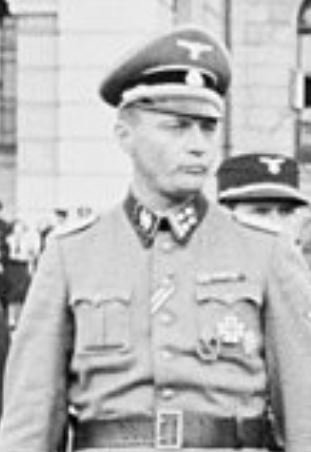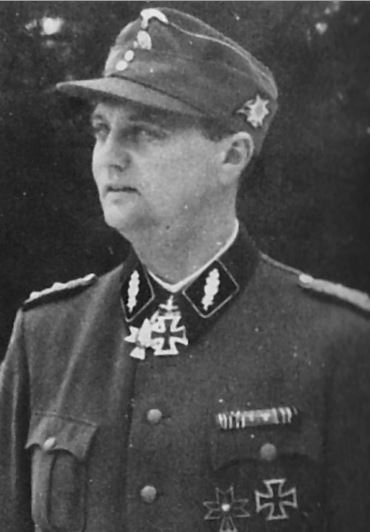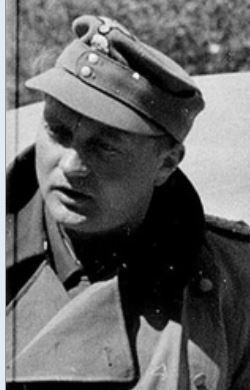Petersen, Heinrich (SS-Gebirgsjäger-Regiment 1)
- Date of birth:
- March 31st, 1904 (Sonderburg/Schleswick, Germany)
- Date of death:
- May 9th, 1945 (near Melnic/Bohemia and Moravia. Czechoslowakia)
- Service number:
- SS-Nr.: 134.299 // NSDAP-Nr.: 1.964.574
- Nationality:
- German (1933-1945, Third Reich)
Biography
Heinrich Petersen comitted suicide on 9th May 1945 as SS-Standartenführer and Führer 18. Panzergrenadier-Division "Horst Wessel".
Promotions:
15.01.1931: Oberfeldwebel
01.03.1933: SS-Anwärter
10.02.1934: SS-Rottenführer
17.02.1934: SS-Scharführer
24.02.1934: SS-Truppführer
10.03.1934: SS-Obertruppführer
05.04.1934: SS-Sturmführer / SS-Untersturmführer
09.09.1934: SS-Obersturmführer
20.04.1935: SS-Hauptsturmführer
09.11.1937: SS-Sturmbannführer
00.02.1938: Oberleutnant der Reserve
01.09.1941: SS-Obersturmbannführer
09.11.1943: SS-Standartenführer
Career:
01.03.1933: joined the NSDAP
00.03.1933: joined the SS, III. Sturmbann, SS-Standarte 46, Dresden
00.04.1934: SS-Ustuf, Taktiklehrer, SS-Junkerschule Bad Tölz
00.08.1935: SS-Ostuf, SS-Wachtruppe 'Brandenburg'
00.00.1938: SS-Stubaf, Kdr, III. Sturmbann, SS-Totenkopf-Standarte 2 'Brandenburg' after unit renaming
00.10.1939-00.02.1941: SS-Stubaf, Kdr, II. Bataillon, SS-Totenkopf-Infanterie-Regiment 3, SS-Division 'Totenkopf', SS-VT - campaign in the West
00.02.1941-00.01.1942: SS-Ostubaf, Führer, I. Bataillon, SS-Panzergrenadier-Regiment 6 'Theodor Eicke', 3. SS-Panzergrenadier-Division 'Totenkopf'
00.01.1942: SS-Ostubaf, Führer, Ersatz-Bataillon, SS-Freiwilligen-Legion 'Nordland'
00.03.1942-00.10.1942: SS-Ostubaf, Führer, SS-Totenkopf-Infanterie-Regiment 3, 3. SS-Panzergrenadier-Division 'Totenkopf'
00.10.1942: SS-Ostubaf, Führer, SS-Ausbildungs und-Ersatz-Bataillon, SS-Gebirgsjäger-Regiment 'Nord', 6. SS-Gebirgs-Division 'Nord'
16.04.1943-22.10.1943: SS-Ostubaf, Führer, SS-Gebirgsjäger-Regiment 1, 7. SS-Freiwilligen-Gebirgs-Division 'Prinz Eugen'
22.10.1943-24.01.1944: SS-Ostubaf, Führer, SS-Gebirgsjäger-Regiment 13 'Arthur Phleps', 7. SS-Freiwilligen-Gebirgs-Division 'Prinz Eugen'
00.11.1943-00.02.1944: SS-Staf, Stab, V. SS-Gebirgs-Korps
00.02.1944-00.06.1944: Führer-Reserve
13.06.1944-15.03.1945: SS-Staf, Kdr, SS-Panzergrenadier-Regiment 39, 18. Freiwilligen-Panzergrenadier-Division "Horst Wessel"
15.03.1945: SS-Staf, Kdr, 18. Freiwilligen-Panzergrenadier-Division "Horst Wessel"
09.05.1945: SS-Staf, commited suicide in Melnic, between Tábor and Pilsen, Bohemia
Do you have more information about this person? Inform us!
- Period:
- Second World War (1939-1945)
- Rank:
- SS-Sturmbannführer (Major)
- Unit:
- Führer, II. Bataillon, SS-Totenkopf-Infanterie-Regiment 3, SS-Division 'Totenkopf', SS-VT
- Awarded on:
- May 30th, 1940
- Period:
- Second World War (1939-1945)
- Rank:
- SS-Sturmbannführer (Major)
- Unit:
- Führer, II. Bataillon, SS-Totenkopf-Infanterie-Regiment 3, SS-Division 'Totenkopf', SS-VT
- Awarded on:
- June 27th, 1940
- Period:
- Second World War (1939-1945)
- Rank:
- SS-Sturmbannführer (Major)
- Unit:
- Führer, II. Bataillon, SS-Totenkopf-Infanterie-Regiment 3, SS-Division 'Totenkopf', SS-VT
- Awarded on:
- November 1st, 1940
- Period:
- Second World War (1939-1945)
- Awarded on:
- 1942
- Period:
- Second World War (1939-1945)
- Rank:
- SS-Obersturmbannführer (Lieutenant-colonel)
- Unit:
- Kommandeur, SS-Gebirgsjäger-Regiment 1, 7. SS-Freiwilligen-Gebirgs-Division "Prins Eugen"
- Awarded on:
- November 13th, 1943
“On the 10.09.1943 SS-Obersturmbannführer Petersen (who was at the time serving far from the Division as an independent commander) took over command of the Kampfgruppe that had recently been transported via air from Mostar to Sinj. The XV. Gebirgs-Armee-Korps intended that this Kampfgruppe would occupy the city of Split. Only very weak forces were available to Petersen (consisting of the I./Geb.Jg.Rgt. 1, IV./Geb.Jg.Rgt. 1 and the I./Geb.A.R. 7), and all of these were without horses and motorized transport following their aerial transport to Sinj.
After he had arrived in Sinj during the late afternoon of the 10.09.1943 he rushed forwards with the IV./Geb.Jg.Rgt. 1 and the I./Geb.A.R. 7 in order to link up with I./Geb.Jg.Rgt. 1. This unit had landed earlier than the rest, and thanks to skillful leadership it was able to disarm the strong Italian garrison at Castle Klis at 10:00 on the 11.09.1943.
The Kampfgruppe then encountered strong enemy resistance near Brnace, and after defending against a major attack north of Dugo Poljo (which was fended off by around 23:00 following bitter close combat) the Kampfgruppe continued to press forward during the night starting at around 01:00 on the 12.09.1943. However, at around 02:00 it came under surprise attack at from the commanding hills of Kocino Brdo (487) and Sv. Gospa (354). Hill 354 was taken by storm. During the early morning Petersen repulsed fresh new attacks by the enemy (who recognized the importance of Klis) and then threw the enemy back with bloody losses following an assault from the high ground.
At around 11:30 the I./Geb.Jg.Rgt. 1 succeeded in its breakthrough despite having been repeatedly attacked and threatened itself.
Statements from agents as well as the civilian population indicated that the bandits were masters of the situation (the Italian commander of Klis reported that 4-5000 bandits were located between Klis and Split). The facts on the ground suggested that only swift and determined intervention by the Kampfgruppe would be able to bring the city of Split under friendly control, and so the commander decided to head out towards Split on the same day. At 16:30 Petersen commenced his advance towards Split whilst leaving behind only weak elements to guard the Castle.
The attack of the Kampfgruppe (which was at a major disadvantage in numbers and artillery) bogged down under the vicious flanking fire from bunkers that dotted the commanding hills (especially Hills 602 and 616). At 18:00 the Kampfgruppe was pulled back to Klis.
Petersen relaunched his attack on the 14.09.1943, this time trying to eliminate the bunkers on the hills by splitting up some of his forces. At 14:00 the I./Geb.Jg.Rgt. 1 reached the water filled ditch before Solin (located 3 km north of Split). However both Hills 602 & 616 as well as the heavily fortified bunker line before Solin proved to be impossible to conquer given the available friendly forces. The Kampfgruppe was forced to pull back to Klis once again, where it became encircled on all sides. It thus took up a defensive posture.
Petersen and his small body of troops defended the Castle and village of Klis for a full 9 days (the 15.-23.09.1943) in the face of multiple day and night attacks launched by overwhelming enemy forces against the defenders’ narrow perimeter. The bandits’ concentrated artillery fire (delivered by the light and heavy artillery batteries they had acquired from the Italians) rained down on the garrison without pause. The friendly Stukas that had been sent to provide relief only inflicted modest damage against the enemy forces that were entrenched in concrete bunkers and rock crags.
The II./Geb.Jg.Rgt. 1 (which had already been airlifted to Sinj on the 15.09.1943 in order to reinforce the Kampfgruppe) was itself encircled in Sv. Jakob (located 7 km NE of Klis) and began a fight for its survival against overwhelming numbers of bandits. For his part the divisional commander swiftly assembled a scratch motorized Kampfgruppe and personally led it along the rocky coastline from the east in order to relieve Kampfgruppe Petersen. However this unit was brought to a halt NE of Omis by enemy forces (which carried out unbridgeable road demolitions).
The situation of Kampfgruppe Petersen became graver and graver. In this mountainous terrain aerial resupply could be instantly made impossible by bad weather, and the insufficient care was available for the wounded. Meanwhile the enemy pressure from the commanding hilltops on both sides of Klis continued to increase. Additional forces for a relief effort were not at hand. Thus, on the 18.09.1943 the Division gave Kampfgruppe Petersen the choice between holding Klis or breaking out towards Sinj. In this situation Petersen made the independent decision to hold Klis at all costs, even though he did not know at this time whether relief would be forthcoming (see attachment 1, a field sketch dated 17:00 on the 18.09.1943).
During the entire offensive by his Kampfgruppe SS-Obersturmbannführer Petersen consistently intervened at the hotspots of the fighting, and during the difficult days of the encirclement he gave his men an inspiring example of a fighter’s resolve. Above all it was his brave decision to hold Klis to the last man that enabled the city to be used as a future offensive springboard. This would come to pass when the divisional commander commenced an attack towards Split using a Kampfgruppe based on the Gren.Rgt. 92 (mot), which was brought up on the 25.09.1943. Petersen was thus decisively involved in the eventual capture of Split. All these achievements have rendered him as one worthy to be decorated with the Knight’s Cross of the Iron Cross.”
proposed and validated the 03.11.1943 by Div. Kdr. Carl Reichsritter von Oberkamp
- Period:
- Second World War (1939-1945)
- Rank:
- SS-Obersturmbannführer (Lieutenant-colonel)
- Unit:
- Kdr, SS-Gebirgs-Jäger-Regiment 13, 7. SS-Freiwilligen-Gebirgs-Division “Prinz Eugen”
- Awarded on:
- 1943
- Period:
- Second World War (1939-1945)
- Rank:
- SS-Obersturmbannführer (Lieutenant-colonel)
- Unit:
- Kdr, SS-Gebirgs-Jäger-Regiment 13, 7. SS-Freiwilligen-Gebirgs-Division “Prinz Eugen”
- Awarded on:
- 1943
Sources
- Photo 1:
- Photo 2:
- Photo 3:
- - FELLGIEBEL, W.P., Elite of theThird Reich, Helion & Company Limited, Solihull, 2003.
- MOONEY, PETER, Waffen-SS Knights and their Battles, Schiffer Publishing, Ltd., 2012.
- Axis History Biographical Research via Axis History Forum
- Microfilm Publication A3343. US National Archives






















